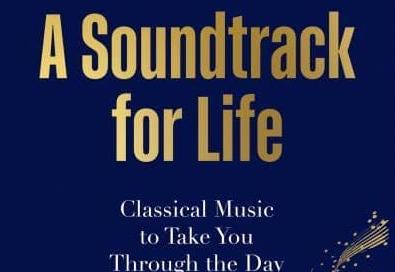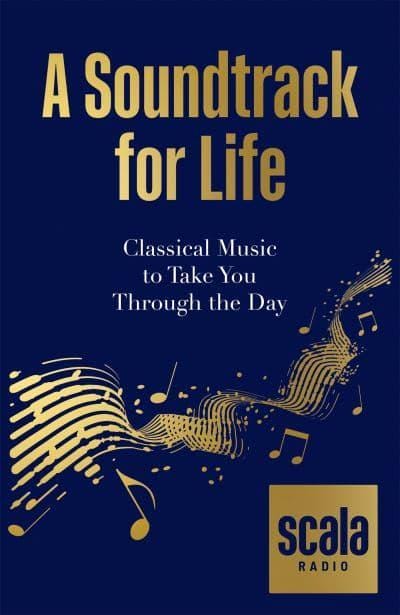The newsletter last fortnight took a look at the cutting process and what gets left out of books rather than what gets shoe-horned in. Rather surprisingly (to me, anyway), quite a number of you got in touch and asked if there was any more material lurking at the back of the electronic drawer.
There is indeed. So I’ll continue the theme this week by including four pieces I wrote for my 2021 book A Soundtrack for Life, written for Scala Radio and published by Octopus. As they put it: “Bringing together much-loved masterpieces with exciting new works, this accessible and inspiring guide is a celebration of classical music.” While there are the obligatory entries (Lark Ascending, Beethoven’s ‘Pastoral’, etc), there are also examples I suspect many of you will not have come across, such as the soundtracks to video games Assassin’s Creed, Halo, and Everybody’s Gone To The Rapture. Overall, I was pretty pleased with how it turned out and so were they.
Naturally, not everything I wrote was included. These four pieces were in fact the first samples I sent through after we’d chatted about the book in a search to find the right tone of voice and the right kind of choice. These failed on both counts (they basically wanted something chattier), but that didn’t matter as that helped me to get more of a feel for what they did want. The next samples were, happily, bang on the money and off I went on my merry lockdown writing way. Here they are, and even though they didn’t end up in print, I’m still quite pleased with them. I have added links to the music so you can listen and read at the same time. The wonder of modern media, eh?
Cantus Arcticus (Concerto for Birds and Orchestra) by Einojuhani Rautavaara
Finnish composer Einojuhani Rautavaara (1928-2016) explored many different ways of making music including a period of avant-garde serialism, and maintained an interest in mystical themes, especially related to angels, throughout his career. His most internationally famous work was something truly unique.
In Cantus Arcticus (1972) he did not just mimic the sounds of nature, he actually incorporated them, blending his composition for flute, oboe, clarinet, bassoon, horn, trumpet, trombone, celesta (an instrument most famously heard in Tchaikovsky’s Dance of the Sugar Plum Fairy from his The Nutcracker), and strings with samples of taped recordings of birdsong which he recorded in northern Finland and near the Arctic Circle.
He was not the first composer to be fascinated by birdsong. In his Quartet for the End of Time – partly written in a German prisoner of war camp - the French composer and keen ornithologist Olivier Messiaen used a violin and clarinet to imitate the song of the nightingale and blackbird. Many of his later works, including Reveil d’Oiseaux (Dawn Chorus) and Oiseaux Exotiques (Exotic Birds), also feature birdsong he had heard, recorded and accurately transcribed. As an excellent example of how his work dovetails with nature it’s worth searching out a recording by young British pianist Julian Trevelyan of The Curlew from Messiaen’s expansive Catalogue d’Oiseaux (Catalogue of Birds), recorded in the reed beds at Snape Maltings in Suffolk [here it is below].
But Rautavaara took the use of birdsong as step further. His concerto is arranged in three movements. First ‘The bog’ (featuring the actual sounds of marsh birds during their spring migration), then ‘Melancholy’ (which includes the call of shore larks Eremophila alpestris, slowed down for extra effect to produce what Rautavaara called the sound of a “ghost bird”), and finally ‘Swans migrating’ (with whooper swans (Cygnus cygnus). The recorded bird sounds and the instruments swoop and overlap, not perfectly synchronised but still together in what feels like a conversation.
It is an extremely atmospheric piece. Close your eyes while you listen and you will instantly visualise a spartan rural setting in the Arctic, though one bursting with life – in the last section, Rautavaara really captures the feel of a flock of birds flying together and then fading away into the distance. Here, he mimics the movement of the birds rather than their voices. The composer himself said that as he wrote it, he imagined them flying “straight to the burning sun”.
Indeed, his performance notes to the piece are equally poetic. The flautists in the first movement are instructed to “think of autumn and of Tchaikovsky” during their duet and later the musicians are urged to “Imitate the swans”.
A Trumpeter’s Lullaby by Leroy Anderson
The trumpet may seem more suited to the drama of Gustav Mahler’s Fifth Symphony or a rousing military piece such as William Walton’s Spitfire Prelude and Fugue than a gentle lullaby. But American composer Leroy Anderson’s 1949 two and a half minute composition for solo trumpet and orchestra shows off the lighter side of the instrument with a remarkably catchy melody.
A calm opening section is followed by a more animated depiction of a child remembering a busy day, followed by a return to the initial tranquility as they falls asleep. It sounds deceptively simple and is a popular piece for those learning the trumpet to help with their articulation, but is also a favourite of professional players, especially as part of their encore repertoire. Among the the many who have recorded it are Wynton Marsalis and Mexican trumpeter Rafael Méndez (a slightly more sprightly rendition) whose versions are worth hunting down.
Anderson (1908-1975) wrote it for the French-American trumpeter Roger Voisin as an alternative to what he described as “traditional trumpet solos which are all loud, martial or triumphant” and because he had never heard a lullaby written for the trumpet. Voisin was among the 20th century’s greatest trumpet performers and teachers, premiering A Trumpeter’s Lullaby for the venerable Boston Pops Orchestra which concentrates on light and popular music.
The Hurdy-Gurdy Man/Der Leiermann by Franz Schubert
If you’re looking for something thoughtfully bleak, then the final song in Schubert’s cycle Winterreise (Winter Journey) is an ideal choice. Written by the German composer in 1828 using poems by Wilhem Müller, it was one of the last pieces he worked on before his untimely death, probably due to syphilis, at the end of that same year aged just 31.
Despite his early demise, Schubert was impressively prolific. In addition to a dozen symphonies (not all completed) and numerous string quartets, operas, overtures, masses, and piano sonatras, he wrote more than 600 ‘lieder’, the German song form which dates back to medieval times. They became hugely popular in the 19th century and Schubert was instrumental in their rise in status, particularly adept in marrying the words and music in a balanced way for single voice and piano.
Winterreise reflects Schubert’s own troubled state of mind while he was writing it and while beautiful, also makes for gloomy listening. The cycle of two dozen songs is an hour long and starts with a young man’s sadness at a lost love. There is no firm plot but the man is on a journey, moving from his town via a coal burner’s hut, past a crossroads, and ending up at a cemetery, the wintry imagery of the words mirroring throughout the psychological iciness enveloping the narrator singer’s heart.
The journey ends as he comes across Der Leiermann of the title, an elderly musician playing a hurdy-gurdy - a stringed instrument which is cranked by hand - as best he can despite his numb fingers. The poem tells us he is barefoot and penniless, with nobody interested in his music except the local dogs who growl at him. The unnamed man, in total despair, wonders if he should accompany the strange old man and then the cycle finishes. To match the desolate lyric, Schubert provides a very sparse and repetitive melody for the piano.
Like the other 23 songs in the cycle, it is written for tenors though often transposed to suit other voice types. It is usually sung in German and is a particular favourite of Ian Bostridge, who has also written an excellent book about it, Schubert’s Winter Journey: Anatomy of an Obsession – interestingly, Bostridge writes about imagining Der Leiermann as “a sort of Bob Dylan song that doesn’t conform to classical norms in singing”. But there are also excellent recordings of it in English by Roderick Williams and particularly poignantly the Irish baritone Harry Plunket Greene in 1934 when the great singer was himself close to the end of his life and his voice, with all due respect, was not quite what it once was.
Anderson trained at the prestigious New England Conservatory of Music (NEC) in Boston, Massachusetts. He described his work as “concert music with a pop quality” and made his name with a series of pieces inspired by the rhythms of the real world. His most famous other works are Sleigh Ride (which finishes with the trumpeter imitating a horse’s whinny), The Syncopated Clock (1945), The Typewriter (1950, the signature tune for The News Quiz in BBC Radio 4) and Forgotten Dreams (1954) which was used 50 years later as the music in an advertisement for 3 Mobile.
Winter Bonfire by Sergei Prokofiev
The Troika movement from the Lieutenant Kijé Suite is the most famous of the ‘Christmassy’ pieces by Russian composer Sergei Prokofiev (1891 –1953), whether it’s the jazzy Midnight Sleighride version by Eddie Sauter and Bill Finegan from the 1950s or Greg Lake’s earnest 1975 song, I Believe in Father Christmas. Winter Bonfire is less well known but is an equally beautiful piece for the festive season, even though it was emphatically not a ‘Christmas’ piece because of the regime’s wary attitude towards religious celebration.
The piece depicts a children’s fun day out to a state farm as part of their Pioneer group, the organisation which replaced the Scout Movement after the end of the Russian Civil War. Split into several distinct sections, it begins with the rhythmic sound of the train transporting the Pioneers into the countryside, followed by a depiction of snow falling, skating on ice (a charming waltz), the lighting of a bonfire – the children sing a short song at this point describing how they throw brushwood onto the flames - evening drawing in, and finally a return home again by train. It all feels evocatively Russian.
Originally, Prokofiev’s work – written over the winter of 1949/50 - was accompanied by a slightly excitable text written by the Russian poet and publisher Samuil Marshak who wrote many poems for children. Apart from the bonfire song, this is not usually included in recordings or performances, although there is a recording by French actor and narrator Vincent Figuri in which he speaks Marshak’s text over the top of the music (available in both English and French). It’s debatable whether this works, though children listening may enjoy the marriage of words and music. In performance, the narration is often spoken at the start of each section as Prokofiev intended, leaving the music to speak for itself. There is an excellent instrumental only version, with a lovely choir for the bonfire song, performed by the Prague Radio Children’s Chorus and Orchestra.
Prokofiev’s most famous work for children is Peter and the Wolf (1936), but he liked children (he had two sons of his own) and wrote many pieces to be enjoyed and played by them, a happy fit with the Soviet authorities’ encouragement to composers to produce music specifically for younger listeners’ enjoyment and education. His suite Summer Day is something of a seasonal companion piece to Winter Bonfire.





